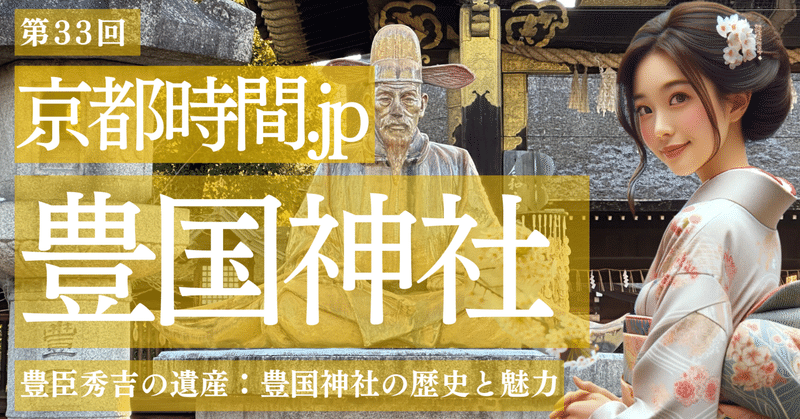
【京都時間.jp】第33回 豊臣秀吉の遺産:豊国神社の歴史と魅力
豊国神社は、京都市東山区の美しい自然に囲まれた阿弥陀ヶ峯にあり、日本を代表する戦国時代の英雄、豊臣秀吉を祀る神聖な場所です。この神社の創設は、秀吉の歴史的業績とその後の影響、そして彼を記憶し、その遺志を継承しようとする人々の絶え間ない努力によって成り立っています。豊臣秀吉という人物は、その生涯で日本の歴史に深く刻まれ、彼の功績は今日においても多くの人々に尊敬され、称賛されています。

豊国神社の土地は、かつて京都を代表する壮大な大仏を安置していた方広寺の寺領であり、その参道を歩くことは、過去への深い敬意と記憶を今に伝える旅のようです。秀吉の影響力は、彼の居城があった大阪城公園、彼の政策が大きく影響を与えた滋賀県長浜市、そして彼の出身地である名古屋市中村区にまで及び、彼の歴史的足跡が日本全国に広がっていることがわかります。

秀吉の死後、彼の遺体は伝統的な火葬を経ずに伏見城内に安置され、後に京都の大仏の東方、阿弥陀ヶ峯の山頂にそのまま埋葬されました。その麓に建立された廟所は、「大仏の鎮守社」として着工され、秀吉は自身を新たな八幡として祀ることを遺言しました。これらの遺志に従い、社は後に新八幡社と呼ばれ、慶長4年には豊国大明神の神号が与えられ、豊国神社としての歴史が始まりました。

しかし、時の流れと共に豊臣家の影響力は衰え、その神号は剥奪され、神社自体も一時期廃絶の運命を迎えました。明治時代の幕開けと共に、秀吉への再評価が進み、明治天皇の勅命によって豊国神社は再興されました。この再興は、秀吉の歴史的な業績と遺産に対する敬意を新たに示すものであり、神社は別格官幣社に列格されました。旧福岡藩主や蜂須賀茂韶侯爵らが中心となって境内や参道の整備が進められ、豊太閤三百年祭の挙行などを通じて、豊国神社は秀吉を記念する重要な場所としての地位を不動のものにしました。

豊国神社の中心には、国宝の唐門がそびえ立ちます。この唐門は伏見城の城門であったものを移設したもので、桃山時代の華やかな造りが今に伝わる貴重な文化財です。その豪華絢爛な構造は、豊国神社が単なる神社を超え、豊臣秀吉という人物が日本の歴史において果たした役割と、彼の遺産が現代にどのように受け継がれ、尊重されているかを物語っています。この唐門の移設は、日本のもったいない精神と、建築物を長く使い続けるための知恵の象徴です。

豊国神社への訪問は、ただの観光ではなく、豊臣秀吉への敬愛を新たにし、彼の遺した足跡をたどる精神的な旅です。神社の存在は、私たちに過去への敬意を持ち、歴史から学ぶべき重要性を思い出させます。秀吉が日本史に残した不朽の業績を称え、後世にその記憶を継承するための重要な場所であることは疑いようもありません。豊国神社は、その敷地内で行われる市やフリーマーケットを通じて地域社会との結びつきを強化し、人々に親しまれる場となっており、豊臣秀吉という人物が日本の歴史に果たした役割を今に伝える重要な場所として、その価値を未来にも継承していくでしょう。

"The Legacy of Toyotomi Hideyoshi: The History and Appeal of Toyokuni Shrine"
Toyokuni Shrine, nestled in the beautiful nature of Amidagamine in Higashiyama Ward, Kyoto, is a sacred site dedicated to Toyotomi Hideyoshi, a hero of Japan's Warring States period. The establishment of this shrine is built upon Hideyoshi's historical achievements, his enduring influence, and the relentless efforts of those who wish to remember him and carry on his legacy. Toyotomi Hideyoshi's life deeply engraved in the history of Japan, and his accomplishments are respected and admired by many to this day.

The land of Toyokuni Shrine was once part of the temple estate that housed Kyoto's magnificent Great Buddha in Hokoji Temple, and walking its approach is like a journey that conveys deep respect and memory of the past. Hideyoshi's influence extends from Osaka Castle Park, where his castle stood, to Nagahama City in Shiga Prefecture, which was greatly affected by his policies, and to his birthplace in Nakamura Ward, Nagoya City, showing his historical footprints spread across Japan.

After Hideyoshi's death, his body was placed inside Fushimi Castle without undergoing traditional cremation and was later buried intact at the summit of Amidagamine, east of the Great Buddha. The mausoleum built at its base was initiated as the "guardian shrine of the Great Buddha," and Hideyoshi willed himself to be enshrined as a new Hachiman. Following these wishes, the shrine was later called Shin-Hachiman, and in the fourth year of the Keicho era, it was granted the divine title of Toyokuni Daimyojin, marking the beginning of Toyokuni Shrine's history.

However, over time, the Toyotomi family's influence waned, and the divine title was stripped away, leading the shrine itself to face a period of abolition. With the dawn of the Meiji era and a reevaluation of Hideyoshi, Toyokuni Shrine was revived by imperial command of Emperor Meiji. This revival was a renewal of respect for Hideyoshi's historical achievements and legacy, and the shrine was elevated to a special government-supported shrine. Key figures such as the former lord of Fukuoka Domain and Marquis Hachisuka Mochiaki spearheaded the renovation of the shrine grounds and approach, and through events like the Toyotomi Hideyoshi 300th Anniversary Festival, Toyokuni Shrine cemented its status as a significant place of commemoration for Hideyoshi.
At the heart of Toyokuni Shrine stands the national treasure, the Karahafu gate, which was relocated from Fushimi Castle. This gate is a valuable cultural property that conveys the splendor of the Momoyama period. Its lavish structure exceeds that of a mere shrine, narrating the role Toyotomi Hideyoshi played in Japanese history and how his legacy is revered and continued in modern times. The relocation of this gate symbolizes the Japanese spirit of valuing what one has and the wisdom of preserving buildings for prolonged use.
Visiting Toyokuni Shrine is not merely a tourist activity but a spiritual journey to renew admiration for Toyotomi Hideyoshi and trace his legacy. The existence of the shrine reminds us of the importance of respecting the past and learning from history. There is no doubt that Toyokuni Shrine plays a crucial role in honoring Hideyoshi's immortal achievements and passing on his memory to future generations. Through markets and flea markets held on its premises, the shrine strengthens its community ties, becoming a beloved place that conveys the role Toyotomi Hideyoshi played in Japanese history, ensuring its value is passed on to the future.
この記事が気に入ったらサポートをしてみませんか?
